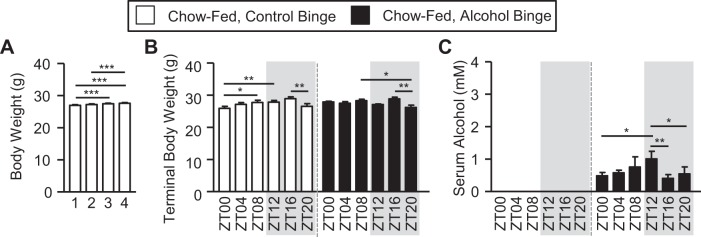Fig. 2.
Chow-fed mice exhibit treatment-induced effects on body weight and serum alcohol levels. Mice were fed a standard chow diet for 4 wk, and during the 5th wk (i.e., days 43–45) mice were administered a once/daily binge of alcohol (6 g/kg) or the vehicle control for alcohol (i.e., PBS) at a specific time indicated by the zeitgeber time (ZT), and mice were euthanized 4 h after the 3rd and final once/daily binge. A: mice were weighed weekly, and body weight significantly increased over the 4 wk of the study (1-way ANOVA, P < 0.00). Post hoc Tukey’s test revealed significant between-week differences. Numbers indicate study week. B: analysis of body weight before tissue collection (i.e., following the 3rd and final binge) revealed a significant main effect of time (2-way ANOVA, P < 0.00) but no effect of binge or an interaction. Post hoc Tukey’s test revealed significant time-of-day differences. C: serum alcohol levels assessed 4 h after the 3rd and final binge and revealed a significant main effect of binge (P < 0.00) but no effect of time nor a binge-by-time interaction (2-way ANOVA). Post hoc Tukey’s test revealed significant time-of-day differences in serum alcohol levels. ZT indicates binge time. Between n = 5 and 10 mice were included in each treatment group at each time point. Post hoc Tukey’s test: *P < 0.05; **P < 0.01; ***P < 0.001.

